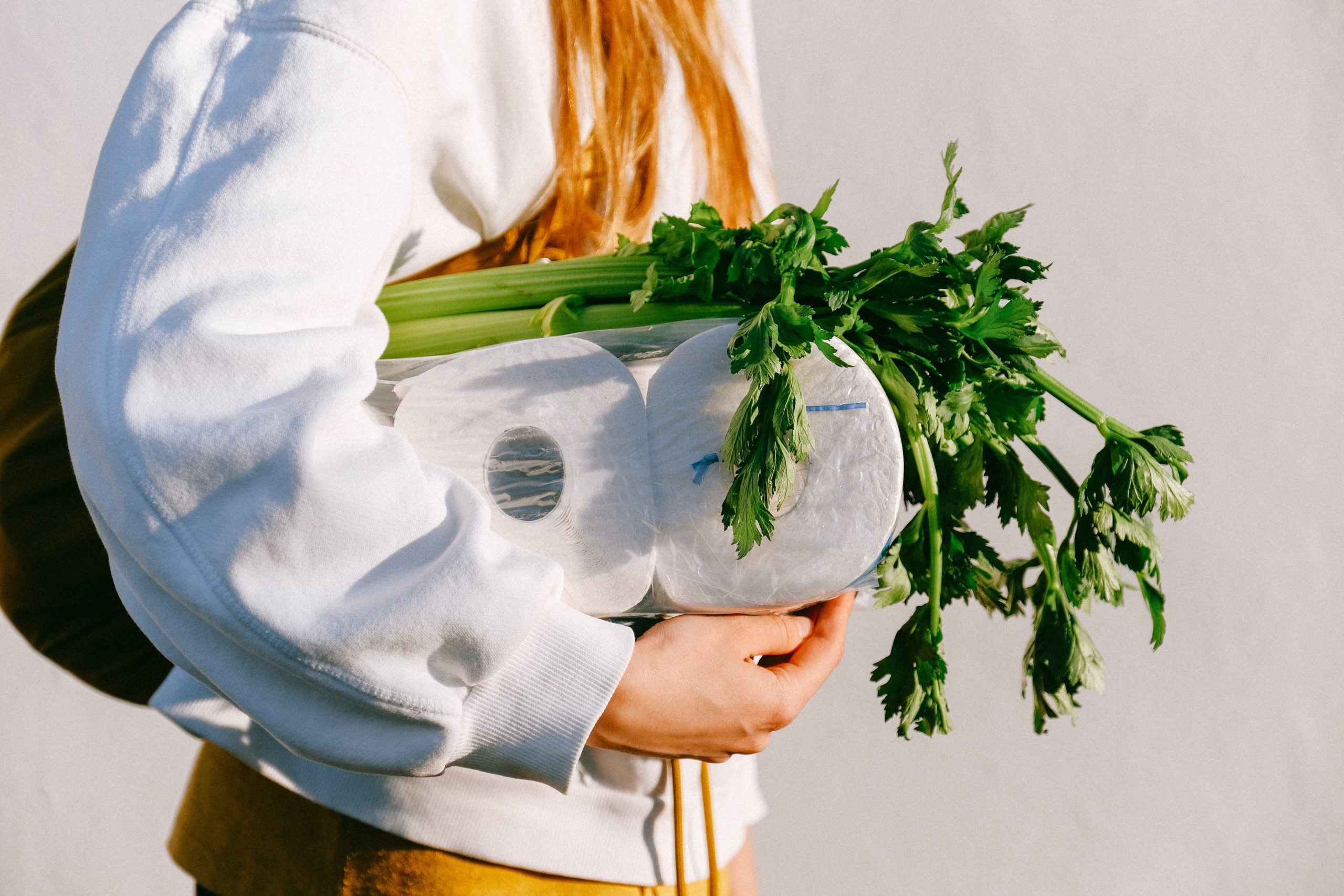Table of Contents:
You're at the store. You've brought your reusable mesh produce bags and sturdy canvas or post-consumer recycled plastic grocery bags. You're keeping an eye out for compostable and recyclable packaging as your browse the pantry and snack aisles.
Then, you reach the toilet paper aisle, and... Oh, boy.
You need it, you know you do. But it's wrapped in so many layers of thick, strong polypropylene plastic. They all are. You walk down the aisle looking at every brand, but they're all the same. Even the "green" toilet paper made from post-consumer recycled paper is wrapped in a non-recycled plastic cover.
Does it have to be like this?
Why are toilet paper rolls packaged in plastic?
It's fairly obvious why most paper products come wrapped in plastic—paper is vulnerable to water, dirt, and other contaminants that can ruin the product. Plastic, on the other hand, is easy to clean, difficult to penetrate, and incredibly low-cost to produce. The most common type of plastic film used to package toilet paper and paper towel rolls is known as polypropylene, which is strong, durable, clear, and (most importantly) cheap.
Even in 2021, you'd be pretty hard-pressed to find paper products that don't come wrapped in plastic for these very reasons. Paper towels, paper napkins, printer and notebook paper, notepads and sticky notes, sometimes even notebooks all typically come in plastic packaging. However, if you've ever worked in an office or for an organization that buys toilet paper in bulk, you know that each roll often comes individually wrapped in paper in a large cardboard box of rolls. So, we know that it's possible, realistic even. But why isn't it common?
One hypothesis is that see-through packaging (aka "plastic") is a cornerstone of good product packaging. The consumer prefers to see the actual product rather than it being hidden behind an opaque veil of paper--the same reason that toys have a plastic window in the front of the box. From a sales perspective, this makes sense--we're much more likely to trust the product if we can see it. If this really is part of the reasoning behind using clear plastic to cover the toilet paper, then it also explains why when it's sold in bulk companies seem to have no qualms about wrapping it up in paper. After all, when your office manager is ordering the cheapest toilet paper for their company's employees, they probably couldn't care less about the quality or particulars of the product, as long as it's cheap.
Some also cite the use of plastic in the packaging of paper goods as saving waste in the long run, as it ultimately protects the products from ruin. However, there are other packaging materials that can protect the paper similarly well, which I will discuss below.
Personally, however, I don't much care what my toilet paper looks like and am just as happy buying it without being able to see through the packaging. So long as it does the job, that's all I'm in it for.

Alternative materials
As mentioned above, wrapping toilet paper with paper isn't completely unheard of, or even new. But it does remain atypical when purchasing in average household quantities.
Paper is largely considered to be a more environmentally friendly material than plastic as it's almost always recyclable, biodegradable, and even compostable. But even so, trees are a nonrenewable resource and are not infinitely recyclable. Additionally, recycling isn't the most sustainable process either. So, what is the best material for packaging our paper goods?
One option that's rapidly gaining popularity as a sustainable paper replacement is bamboo. Bamboo only takes around three years to reach its full height and uses very little water and fertilizer in the process.
Not only are some brands beginning to package toilet paper with this renewable resource, but some companies like Reel, Who Gives A Crap, and Cloud Paper are beginning to produce "tree-free" toilet paper entirely made up of and packaged with bamboo fibers, with prices comparable to popular, middle-of-the-road brands like Charmin.
Although recycling paper still uses a fair amount of water and energy, it still greatly reduces the amount of waste that ends up in landfills, reduces carbon emissions, and uses less water and energy than harvesting live trees. Toilet paper made from post-consumer recycled paper is also becoming more common, with somewhat mainstream brands like Seventh Generation, Everspring, and even Who Gives A Crap (who also uses recycled paper as super cute packaging!) distributing these recycled rolls. Although some of these still come wrapped in plastic packaging, it's still a step in the right direction for waste, energy, and pollution reduction.

What we can do
Unlike many other environmental issues with manufacturing and consumerism, there are actually some reasonably simple cost-effective options to combat this one making voting with your wallet a legitimate and practical solution.
Below are a few reasonable ways that you can vote with your wallet without breaking it.
Look for toilet paper made from or packaged with alternative materials
As I mentioned above, there are several up-and-coming and established brands that are making their toilet paper 100% out of bamboo fibers or recycled paper. This is absolutely the most sustainable option when it comes to toilet paper (or paper towels, tissues, etc.) because it results in little waste altogether from production to purchase, and often these companies do more for the environment with their profits.
For example, the company Reel, which sells toilet paper that is both made from and packaged with bamboo fibers, donates a portion of its earnings to a nonprofit in Haiti that provides toilets and waste removal from underserved communities. Who Gives a Crap is a popular plastic-free subscription that offers both recycled and bamboo toilet paper, and they donate half of their profits go to a health initiative that helps provide clean water, build toilets, and provide health and hygiene education to underserved communities. And finally, there is 100% bamboo brand Cloud Paper, a Seattle-based company started in 2019 that's committed to fighting deforestation and lowering CO2 emissions. This new company regularly donates toilet paper to local organizations in need such as shelters, food banks, and hospitals.
Of course, you can't actually offset the waste of plastic, but you can at least do something for the environment if replacing plastic is not a viable option for you. Some brands, like Seventh Generation or Everspring, are made from post-consumer recycled papers and fibers. Even though they still come in plastic packaging, you can at least minimize the amount of waste you produce when performing necessary tasks.
Although it may be difficult to find non-plastic toilet paper in your local Target (but if you're lucky, you actually can!), there are several options to reduce plastic waste when your family simply must maintain proper hygiene.
Buy a bidet
Bidets are no longer strictly for your posh urban neighbor with their shiny 300 square-foot marble bathroom in their penthouse apartment. In fact, bidets are gaining traction in mainstream America and are becoming increasingly affordable. With a variety of options from bidet attachments, seats, and entire bidet toilets, you can easily find one that suits your budget and your needs, and will ultimately reduce your toilet paper cost and consumption. In fact, you can buy a simple, bare-bones bidet attachment for as low as $35 on Amazon, or a mid-range bidet toilet seat with warm water for around $350.
In 2021, approximately 12.1% of Americans use bidets which, although still a small number, has grown substantially since pre-pandemic days. The Great Toilet Paper Shortage of 2020 bears a heavy responsibility for this peak in popularity, with most companies seeing an increase in bidet sales somewhere between 2% and 20% across 2020 and 2021.
Aside from toilet paper supply shortages, many potential and past bidet-buyers cite reasons such as the desire to be more sustainable, save money on toilet paper, and access better hygiene practices for their interest in the device.
With a bidet, you will still need to purchase toilet paper, but according to Business Insider, the average bidet user uses 75% less toilet paper than they did previously. You may even be able to afford to splurge on a more environmentally friendly brand, or at least find yourself buying regular, plastic-wrapped toilet paper much less often.
Recycle the plastic packaging at the proper sites
Alternatively, if you choose to continue to purchase regular toilet paper brands, you can actually recycle the plastic packaging, just (probably) not in your home recycling bin.
Since there has been a widespread crackdown on single-use grocery bags around the country, many stores where they are still used now have recycling depositories specifically for these plastic bags and other things made from plastic film, including toilet paper wrappers. These drop-off locations can often be found at your local grocery store, department stores such as Target and Wal-Mart, and hardware stores such as Lowe's.
You can search for plastic film recycling locations near you using this directory.
Just keep in mind that plastic is not infinitely recyclable, so although this is still a decent option, it should be thought of mainly as a temporary solution to waste reduction.

Summary
When it comes to sustainability issues, the burden of improvement typically lies outside of the hands of the consumer. However, when it comes to how we wipe our butts, we are more in control than we think. Changing our toilet paper habits may be a bit of a learning curve, but it can be a surprisingly affordable and simple change.


